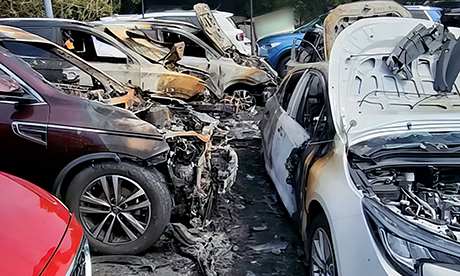Lithium-ion batteries in electric vehicles are both their biggest plus and most dangerous threat – to owners and the environment.
Last Thursday, ABC AM interviewed Catriona Lowe, deputy chair of the Australian Competition and Consumer Commission, to discuss the fire risk of battery charging.
She was speaking after an electric scooter exploded in a fireball at a backpacker hostel in Sydney last Wednesday.
Lowe called for a government consumer awareness campaign about the dangers of lithium-ion batteries that now power everything from phones to vacuum cleaners, power tools and cars.
A few weeks earlier, on September 12, five cars were destroyed at Sydney’s Mascot Airport after a battery detached from a luxury EV ignited.
This column discussed media reporting of EVs on February 6 and on November 15 2021, but did not mention the difficulty of extinguishing EV fires because of what firefighters call the thermal runway.
Global figures make clear EV fires are rare.
But they are an issue.
The specialist US motoring website hagerty.com has explained in detail why many country US race tracks refuse to let EVs or hybrids compete.
It says there are only two ways to deal with lithium-ion battery fires:
“Douse a fire with water to cool it down: a lot of water, between 3000 gallons (11,356 litres) and 30,000 gallons depending on the incident.
“Cooling takes 100 times more water than a gasoline fire.” The other method is to let the fire burn out and then submerge the entire smouldering wreck in water.
EV batteries can be compromised in even small vehicle accidents and that is when they become dangerous.
This is now feeding into soaring insurance premiums in the UK, where the Guardian and the Express newspapers have reported EV insurance premiums are set to rise by up to 1000 per cent.
A spokesman for the Insurance Council of Australia
said it was too early to know what effects EV repair costs
would have on premiums here
but did suggest the cost of importing parts,
scarcity of EV service centres
and problems with battery repair and disposal
would be an issue.
The Guardian on September 30 reported on a young man who bought a Tesla Model Y.
When his policy renewal fell due his insurer refused to reinsure the car.
When he finally found a company that would, his annual premium had risen from £1200 ($A2290) to £5000 in one year.
The Guardian mentioned the increased cost of repairing EVs but did not get to the heart of the issue.
The battery is about half the cost of a new EV and batteries that sit under the car floor are easily damaged in quite minor accidents.
Repairers say fixing batteries is extremely difficult and insurers tend to write off even quite new cars if there is even slight damage to the battery.
This was the problem with the Sydney Airport fire. The car’s battery had been damaged and damaged batteries are more likely to catch fire.
Taking up the challenge, Fire and Rescue NSW in July launched a two-year project called Safety of Alternative Renewable Energy Technologies. This will look at lithium-ion fires, end-of-life battery hazards and EV fires in structures such as parking garages.
The website EVFireSafe.com, set up by the federal government, is a good place to start if you want to understand why lithium-ion fires are difficult to control. Continue reading
